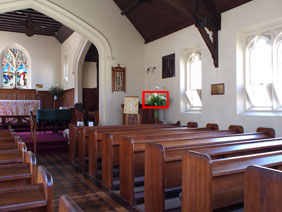Olympus ‘PEN’ E-P2
-
-
Written by Gordon Laing
Olympus E-P2 vs Nikon D90 High ISO JPEG Noise
Olympus E-P2 results : Real-life resolution / High ISO JPEG Noise / High ISO RAW Noise / M.Zuiko Digital 17mm lens sharpness
Olympus E-P2 results : Real-life resolution / High ISO JPEG Noise / High ISO RAW Noise / M.Zuiko Digital 17mm lens sharpness
|
 | To compare noise levels under real-life conditions we shot this scene with the Olympus E-P2 and Nikon D90 within a few moments of each other using each of their ISO settings. The E-P2 was fitted with the M.Zuiko Digital 17mm kit lens and the D90 with the DX 18-105mm kit lens, the latter adjusted to match the vertical field of view. Each shot was taken in Aperture Priority with Auto White Balance. For this page we used the best-quality JPEG modes of each camera with their default settings. See matched RAW results in our High ISO RAW Noise page. |
The image above was taken with the Olympus E-P2 in Aperture Priority mode at 17mm f5.6 with a sensitivity of 100 ISO. The original JPEG measured 5.09MB. The exposure as metered by the E-P2 was 0.77 seconds. The same exposure at f8 and 100 ISO on the D90 would have required a shutter speed of 1.5 seconds, but as with the previous page, this delivered an image that was brighter and over-exposed. In order to match the E-P2’s middle-grey brightness required an exposure of one second at 100 ISO f8 on the D90, which coincidentally was what the camera metered without compensation. This does however mean the D90 was again operating at around a 2/3 EV difference.
The crops are taken from the area marked with the red rectangle and presented below at 100%. Note the Nikon D90 captures wider 3:2 aspect ratio images, so by matching the vertical field of view, we’re effectively treating the DSLR here as a 10.8 Megapixel camera, delivering 4:3 shaped images. As such, the D90’s crops show a slightly larger area due to its lower vertical resolution.
As mentioned earlier, we chose the D90 for comparison here as it can be bought in its standard kit for pretty much the same money as either of the E-P2 kits. Obviously they’re very different cameras, but illustrate what you could buy for roughly the same budget. It also allows us to compare the performance of the E-P2 against a traditional DSLR and see if its noise levels can keep-up. Note you can also match the D90’s image quality with the more affordable Nikon D5000.
We used the default noise reduction settings for each camera, and any contrast adjustment options were disabled as they can artificially increase visible noise levels. As such, Active D-Lighting on the Nikon was disabled and the E-P2’s Gradation set to Normal.
As before, the results below are pretty much a repeat of what we found with the earlier Olympus E-P1, which shouldn’t be surprising given the same sensor and processing. As such the Olympus E-P2 delivers clean and detailed results between 100 and 400 ISO. Faint noise textures may be visible in the crops below from 200 ISO upwards, but they’re certainly nothing to worry about at this point.
Moving onto the Nikon D90’s crops though, and you’ll see its images are essentially bereft of any noise textures from 100 to 400 ISO, giving it the preferred result here. To be fair though, the E-P2’s image processing using the default settings isn’t doing it any favours here. As seen on our first results page, the E-P2 is applying much greater sharpening and contrast than the Nikon, and this in turn is making any subtle noise textures much more obvious. Tone down the settings or adjust the noise reduction and you can achieve cleaner-looking results at higher sensitivities.
That said, returning to the crops below, the E-P2 takes a noticeable turn for the worse at 800 ISO, with a softer overall appearance and a loss of fine detail, while the D90 still holds it together at this point.
At 1600 ISO the E-P2 suffers from more visible noise artefacts than before and is noticeably worse than the D90, although it’s a world-apart from a typical compact. With the sensitivity increased to 3200 ISO, noise has become quite obtrusive on the E-P2, whereas the D90 remains comparatively clean. Finally, at 6400 ISO, the Nikon D90 has certainly become noisier than before, but there’s no contest: it delivers a much preferable result to the E-P2.
In terms of comparing sensor real-estate, this isn’t a surprising result overall. The D90 features a larger APS-C sensor and also enjoys some of the best High ISO results we’ve measured for any DSLR. But the bottom line is the output from the E-P2, like the E-P1 before it, is considerably superior to a traditional compact at higher sensitivities, giving it the low-light advantage of a DSLR in a much more portable form factor – but like other models which use a Four Thirds sensor, just don’t expect it to keep up with the best APS-C DSLRs on the market. This is a camera which is happiest operating below 800 ISO.
So far so similar to our report from the E-P1, but we’re going to go a little further here and present a set of High ISO Noise results taken from RAW files with each camera. Not only does this show what the camera’s really capable of, but it allows us to better match the image processing style between the E-P2 and D90 for a more level playing field. So head on over to our E-P2 High ISO RAW Noise results.
Olympus E-P2: JPEG with Olympus M.Zuiko Digital 17mm f2.8 |
Nikon D90: JPEG with Nikkor DX 18-105mm VR | |
 |  | |
100 ISO |
L1.0 (100 ISO) | |
 |  | |
200 ISO |
200 ISO | |
 |  | |
400 ISO |
400 ISO | |
 |  | |
800 ISO |
800 ISO | |
 |  | |
1600 ISO |
1600 ISO | |
 |  | |
3200 ISO |
3200 ISO | |
 |  | |
6400 ISO |
H1.0 (6400 ISO) |





